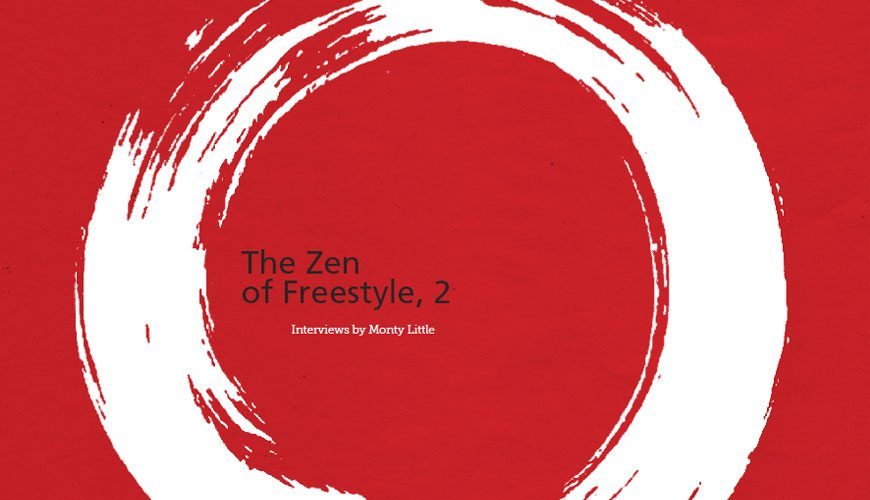
It’s 6:30 a.m. and I am dreading the rather dull hour-long commute into Vancouver. To make things worse, it’s raining and still dark outside. Flipping through the stations on the radio, I hone in on an upbeat song – and since I’m familiar with it, I sing along: “She’s got a heart of gold, she’d never let me down. But you’re the one that always turns me on, you keep me comin’ round.” The lyrics suggest the singer has another love in his life. But it’s not another woman; it’s his guitar. He loves playing it so much that it may be jeopardizing another relationship. That love affair is similar to the one freestyle skaters have with their skateboards. They spend hours and hours in solitude practicing tricks that, when mastered, give the illusion that the board and rider are truly one, mirroring the Zen philosophy of mind and body coinciding in perfect harmony. In this second article, looking into the lives of some of the world’s top freestyle skaters, we talk about the Zen relationship they have with their board and what drives them to perfection.
Lynn lives with his wife and their two cats, Barney and Mini-Cooper, on five acres hidden in a small valley 45 minutes south of Denver, Colorado. Besides being a technical director for one of the world’s largest software companies, Lynn is also accomplished behind the lens of a video camera and is the official videographer of the Colorado 8th Air Force Historical Society. A real plane buff, Lynn also recently became a certified private pilot.
Lynn, your skating career spans several decades. How old were you when you took it up?
I had a board with clay wheels when I was younger, but I really started in 1975 when I was 14, and have been continuously skating for over 40 years. Back then we weren’t focused on just one element of skateboarding; you did it all: slalom, pools, high jump, banks.
When did you start to dedicate more time to freestyle?
I was competing in a National Skateboard Association contest series, and since you got extra points if you went in more events, I decided to give freestyle a try. When I first 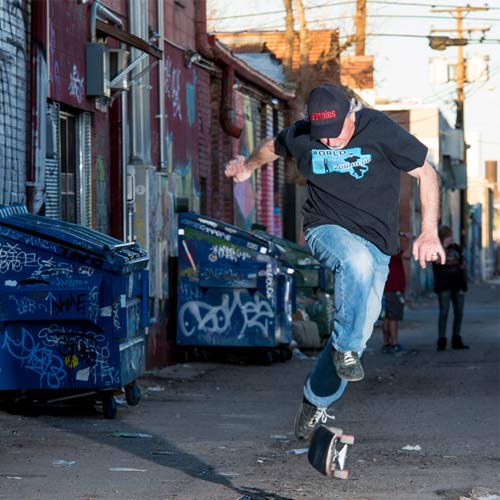 started competing in 1981 I didn’t even have a freestyle board. I took my Eddie Elguera pool board, cut it down and used that.
started competing in 1981 I didn’t even have a freestyle board. I took my Eddie Elguera pool board, cut it down and used that.
I have always thought of you as a freestyler. Do you still skate pools and banks?
Yes, definitely. I enjoy all forms of skateboarding. But freestyle is very different. You don’t have transitions or obstacles to work off of; you just have this flat piece of ground. You have to get creative. There are no rules or expectations; you just take whatever comes out of your body and your mind and just put it out there. It’s similar to when I am tinkering on my guitar; it eventually evolves into a piece of music that I composed. That’s what I get from freestyle; I feel like I’m creating something very unique that makes me feel good about myself.
You seem to put a lot of importance on music in your freestyle routines.
I never gave it much thought until 1982 when I was at a freestyle contest at Paramount Skatepark. I was watching Kevin Harris, whose routine was synchronized to [music from] “Flashdance,” and Per Welinder, who I think skated to “Let’s Dance” by David Bowie. Both of their routines were choreographed to the music; every trick was to the beat of the song. I wanted to skate like that, so I went out to my truck and looked through my cassette tapes until I found “Cold as Ice” by Foreigner and started practicing to it in the parking lot before I went out to skate. After that contest I really focused on flowing with the music, not trying to do so many hard tricks [as] was the norm, but more like Primo Desiderio, whose routines were all about the music.
By the way, congratulations on placing first in the Legends Freestyle Classic at the World Round-Up in Vancouver. What’s it feel like to still be winning contests at age 54?
It was great to skate with my friends and to receive the recognition, but it’s not the contest winnings or the accolades that I consider to be my biggest accomplishments – but rather the many lifelong friends I have made along the way that I truly value the most!
I remember AJ Kohn saying as he was introducing you, “Russ Howell is Lynn’s sensei, and Lynn is the one who influenced my skateboarding.”
The one person I considered to be my coach – who had the largest influence on my 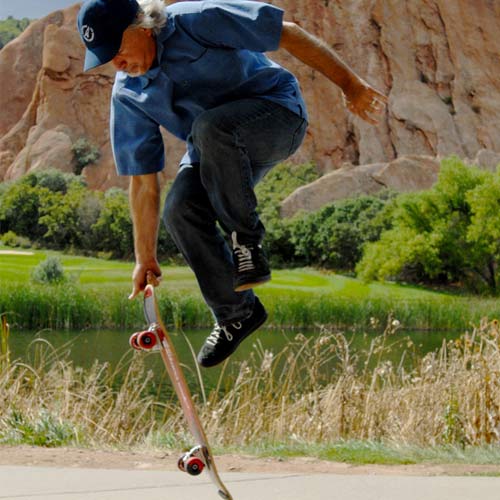 skateboarding – was Russ Howell. Although we were both competing at the Round-Up, it felt more like a demo that I was doing with my teacher, the 1976 world champion and one of my best friends.
skateboarding – was Russ Howell. Although we were both competing at the Round-Up, it felt more like a demo that I was doing with my teacher, the 1976 world champion and one of my best friends.
Last year I took you, Russ and your wives up the Sea to Sky Gondola to see the view of Howe Sound some 2,900 feet below. I mentioned that my grandmother often said to me that the word GOD, besides the obvious, is also an acronym that stands for the Great Out Doors. You said that being one with nature is similar to the peace you get when you are skating freestyle. Could you expand on that?
My work is quite demanding. The one outlet I have from the stresses of life has always been skateboarding. It rejuvenates me just like when I am out in nature; that feeling of being free and leaving all my cares behind. When I step on that skateboard it instantly brings this Zen quality, which in turn brings balance that I apply to my skating. It is then that I can create and really be myself. I get so caught up in it that time seems to stand still even though hours have passed by. Lucky for me, my wife understands the importance that freestyle contributes to my overall well-being.
I know you’ve almost completed your freestyle documentary, Skaters of the Lost Art. Would you be up to sitting down when it’s finished and doing another interview?
For sure. It’s a story in itself.
Any last words for those younger skaters?
As Jean-Luc Picard would say: Engage! In other words, don’t wait for something to happen. Get out there and go for it and be present in everything you do in life. Per lives with his girlfriend of 15 years in São Paulo, Brazil, the 10th-largest city in the world. He works for an advertising company as a photographer, helping to market clients’ brands. Actively involved in promoting freestyle, Per has also developed several skateboard products and is one of the founders of F.L.I.P.S., the Freestyle League of Professional Skaters.
After the guys from the United States, Brazil has consistently had the second-largest representation of skaters at the World Freestyle Round-Up. Six of you showed up this year alone. What is it that keeps bringing you guys back?
You and Kevin Harris have found a way to honor, reward and provide a unique experience to all participants. It’s like this fun demo, disguised as a championship, that promotes the sport globally. Freestyle has always had great public appeal, but then in the late ’80s it was suddenly banished from major competitions for over a decade. You guys have put it back in the forefront, something no one else has been able to do. The other thing that keeps bringing us back is your incredible staff, [who] always greet us with open arms, even putting us up in their homes. That’s why I tell my friends, “I’m going to Canada to see my family.”
It must be well over 6,000 miles from São Paulo to your second home in Vancouver. What’s a flight cost anyway?
From 800 to 1,300 U.S. dollars. If you consider that the monthly base salary in Brazil is $207 U.S., you have an idea how hard it is for an unsponsored skater to get there. You also have to change planes in Chicago or Toronto before you fly on to Vancouver, 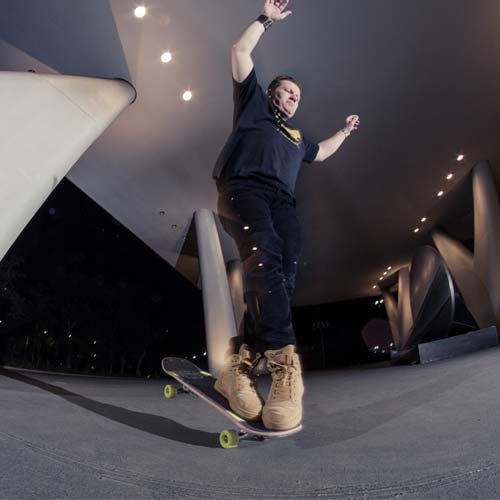 making for an 18- to 24-hour day.
making for an 18- to 24-hour day.
Tell us a bit about how you got into skateboarding.
I was only 8 years old when I started. It was just something we did, skating down the hills in our neighborhood on these cheap boards that were nothing more than toys. Then about six years later I came in contact with freestyle skating. I identified immediately. I was almost hypnotized by the movements and the way the skaters could flow through the court performing amazing tricks.
What’s so different about freestyle?
Most other sports are somewhat robotic and repetitive in nature, almost routine like. Yes, they do take concentration, dedication [and] discipline and you have to be physically fit, but they totally lack any creativity. Freestyle is all about creativity. I always try to be innovative, coming up with new things or expanding on variations of tricks that exist. Striving for perfection is a process I enjoy. Without realizing it, four or five hours have gone by and I’m not even fatigued.
How does your girlfriend deal with your freestyle obsession?
Paula is a powerful influence in my life. Even if she doesn’t come to the skateboard events with me, she gives me all her support. She knows how important skateboarding is to me and understands when I stay longer at a skate session.
What does the term “the Zen of Freestyle” mean to you?
The word Zen is widely used by people looking to lead a quiet life – not necessarily to be 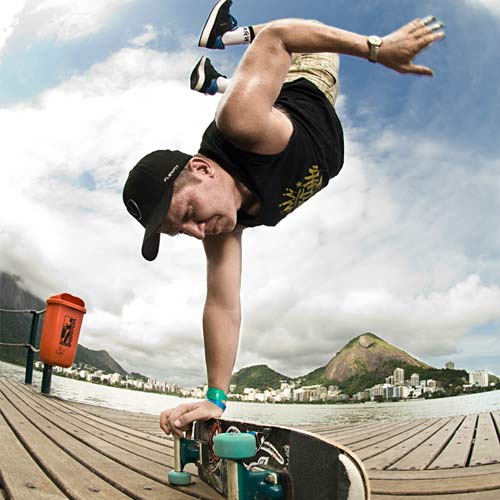 adept to Buddhism, but seeking to avoid problems and always keeping a clear mind. I don’t think of freestyle as a way to skate. For me it’s a form of expression that brings me inner peace. First you turn off the routine of everyday life by concentrating, like meditating. As you focus on your board, your trucks and wheels, everything starts to connect and becomes an extension of yourself. Turning what was impossible yesterday into the possible is pure joy. And, if I can transmit that same feeling to others when I skate, then I am very happy.
adept to Buddhism, but seeking to avoid problems and always keeping a clear mind. I don’t think of freestyle as a way to skate. For me it’s a form of expression that brings me inner peace. First you turn off the routine of everyday life by concentrating, like meditating. As you focus on your board, your trucks and wheels, everything starts to connect and becomes an extension of yourself. Turning what was impossible yesterday into the possible is pure joy. And, if I can transmit that same feeling to others when I skate, then I am very happy.
I noticed your fingers were taped. Did you injure yourself?
I have a long history of injuries (laughing): tendinitis, broken bones, bruised fingers, cuts, etc. It’s not something that should be encouraged. The thing to remember is when you do get injured, your body needs time to recover. The best feeling is when you finally land a trick that you spent days, weeks or months practicing. So don’t let an injury discourage you from trying again and again because the energy you get back from your efforts can be a form of healing. Feeling good about yourself after great effort is far grander than the frustration of not trying at all.
You seem to really connect with the Canadian audience. What’s that all about?
The reason I consider myself half-Canadian is because I have always been very well received by Canadians. I love this country and its people. I know I am being judged by a panel of five judges when I compete, but the crowd’s opinion has always been what I revere the most. And if they communicate with me, get emotional, participate and cheer me on, I win.
Well, I know that I am not the only Canadian that looks forward to seeing you each year. You and your fellow Brazilians are always welcome.
Thankyou Michael Brooke and Concrete Wave Magazine
